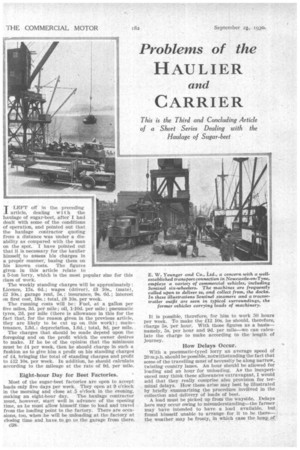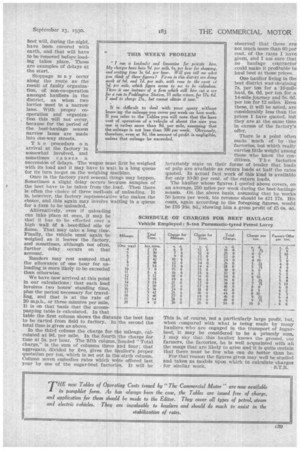Problems of the HAULIER
Page 60

Page 61

If you've noticed an error in this article please click here to report it so we can fix it.
and
CARRIER
This is the Third and Concluding Article of a Short Series Dealing with the Haulage of Sugar-beet
T LEFT off in the preceding 1 article, dealing with the haulage of sugar-beet, after I had dealt with some of the conditions of operation, and pointed out that the haulage contractor quoting from a distance was under a disability as compared with the man on the spot. I have pointed out that it is necessary for the haulier himself. to assess his charges in a proper manner, basing them on his known costs. The figures givenin this article relate to a 5-ton lorry, which is the most popular size for this class of work.
The weekly standing charges will be approximately: Licence, 17s. 6d.; wages (driver), £3 10s., (mate), £2 10s.; garage rent, 5s.; insurance, 9s. ed.; interest on first cost, 18.s.; total, £8 10s. per week.
The running costs will be: Fuel, at a gallon per five miles, 3d. per mile; oil, 1-10d. per mile; pneumatic tyres, 2d. per mile (there is allowance in this for the fact that, for the reason given in the previous article, they are likely to be cut up on this work) ; maintenance, 1,3d.; depreciation, 1.6d.; total, 8d. per mile..
The charges that should be made depend upon the foregoing and on the profit which the owner desires to make. If he be of the opinion that the minimum must be £4 per week, then he should charge in such a fashion as to give him a profit on his standing chargeS of £4, bringing the total of standing charges and profit to £12 10s. per week. In addition, he should calculate according to the mileage at the rate of 9d. per mile.
Bight-hour Day for Beet Factories. '
Most of tile sugar-beet factories are open to accept loads only five days per week. They open at 9 o'clock in the morning and close at 5 o'clock in the evening, making an eight-hour day. The haulage contractor must, however, start well in advance of the opening time, as he must allow himself time to load and travel from the loading point to the factory. There are occasions, too, when he will be unloading at the factory at closing time and. hare to. go. to the garage from there.
e38,
It is possible, therefore, for him to work 50 hours per week. To make the £12 10s. he should, therefore, charge 5s. per hour. With those figures as a basis— namely, 5s. per hour and 9d. per mile—we can calculate the charge to make according to the length of journey.
How Delays Occur.
With a pneumatic-tyred lorry an average speed of 20 m.p.h. should be possible, notwithstanding the fact that some of the travelling must of necessity be along narrow, twisting• country lanes. An hour should be allowed for loading and an hour for unloading. As the inexperienced may think these allowances extravagant, I would add that they really comprise also provision for terminal delays. How these arise may best bf illustrated by briefly summarizing the procedure involved in the collection and delivery of loads of beet.
A load must be picked up from the wayside. Delays here may occur owing to misunderstanding—the farmer may have intended to have a load available, but found himself unable N arrange for it to be there— the .weather may be frosty, in which case the heap _of beet will, during the night, have been covered with earth, and that will have to be removed before loading takes place. Those are examples of delays at the start.
Stoppage m a y occur along the route as the result of faulty organization, of non-co-operation amongst hauliers in the district, as when two lorries meet in a narrow lane. With proper cooperation and organization this will not occur, because for the period of the beet-haulage season narrow lanes are made into one-way streets.
T It e procedure o a arrival at the factory is somewhat involved, and sometimes causes a succession of delays. The wagon must first be weighed with its load and it may have to wait in a long queue for its turn torget on the weighing machine.
Once in the factory yard several things may happen. Sometimes a slight delay occurs because Samples of the beet have to be taken from the load. Then there is often the choice of three methods of unloading. It is, however, the factory representative who makes the choice, and this again may involve waiting in a queue for a turn to be unloaded.
Alternatively, even if unloading can take place at once, it may be that it has to he effected over a high wall of a beet-filled silo or flume. That may take a long time. Finally, the vehicle must again be weighed as it leaves the factory, and sometimes, although not often, further delay occurs on that account.
Readers may rest assured that the allowance of one hour for unloading is more likely to be exceeded than otherwise.
We have now arrived at this point In our calculations: that each load involves two hours' standing time, plus the period necessary for travelling, and that is at the rate of 20 m.p.h., or three minutes per mile. It is on that basis that the accom panying table is calculated. In that table the first column shows the distan4e the beet has to be carted from field to factory. In the second the total time is given as above.
In the third column the charge for the mileage, calculated at 9d. per mile. In the fourth the charge for time at 5s. per hour. The fifth column, headed Total charge," is the sum of columns three and four ; that aggregate, divided by five, gives the haulier's proper quotation per ton, which is set out in the sixth column. Column seven embodies rates which were offered last year by one of the sugar-beet factories. It will be mileage.
Total Time.
(One way) hrs.mins.
4 2 24 5 230 6 236 7 2 42 8
248
9 2 54 10 3 0 11 3 6 12 3 12 13 3 18 14 3 24 15 3 30 16 336 17 3 42 18 348 IS 3 54 20 4 0
observed that these are not much more than 60 per cent, of the rates I have given, and I am sure that no haulage contractor could make it profitable to haul beet at those prices.
One haulier living in the beet district was obtaining 7s. per ton for a '16-mile haul, 6s. 6d, per ton for a 14-mile journey and 5s. 6(1. per ton for 12 miles. Even these, it will be noted, are considerably less than the prices I have quoted, but they are at the same time in excess of the factory's offer.
There is a point often made much of by the factories, but which really carries little weight among those who know the con
ditions. T h e factories invariably state on their forms of tender that loads of pulp are available as return loads at half the rates quoted. In actual fact work of this kind is available for only 10-30 per cent, of the return loads.
The haulier whose figures I quoted above covers, on an average, 250 miles per week during the beet-haulage season. On the above basis, assuming that he works 50 hours per week, his revenue should be £21 17s. His• costs, again according to the foregoing figures, would be £16 168. 8d., showing him a gross profit of £5 Os. 4d.
This is, of course, not a particularly large profit, but, when compared with what is being made by many hauliers who are engaged in the transport of Aug-arbeet, it may be considered to be a princely sum. I may .say that this haulier knows the ground, lee farmers, the factories, he is well acquainted with all the snags that are likely to arise and it is quite certain that there must be few who can do better than he.
For that reason the figures given may well be studied and taken as models upon which to calculate charges
for similar work. S.T.R.












































































































